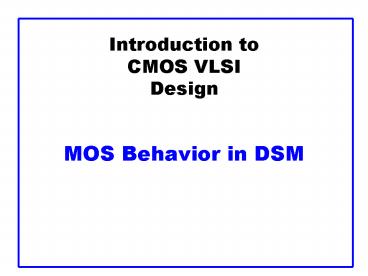Introduction to CMOS VLSI Design MOS Behavior in DSM - PowerPoint PPT Presentation
1 / 30
Title:
Introduction to CMOS VLSI Design MOS Behavior in DSM
Description:
Depends on doping level NA. And intrinsic carrier concentration ni. g = body effect coefficient ... Is depends on doping levels. And area and perimeter of ... – PowerPoint PPT presentation
Number of Views:95
Avg rating:3.0/5.0
Title: Introduction to CMOS VLSI Design MOS Behavior in DSM
1
Introduction toCMOS VLSIDesignMOS Behavior
in DSM
2
Outline
- Transistor I-V Review
- Nonideal Transistor Behavior
- Velocity Saturation
- Channel Length Modulation
- Body Effect
- Leakage
- Temperature Sensitivity
- Process and Environmental Variations
- Process Corners
3
Ideal Transistor I-V
- Shockley 1st order transistor models
4
Ideal nMOS I-V Plot
- 180 nm TSMC process
- Ideal Models
- b 155(W/L) mA/V2
- Vt 0.4 V
- VDD 1.8 V
5
Simulated nMOS I-V Plot
- 180 nm TSMC process
- BSIM 3v3 SPICE models
- What differs?
6
Simulated nMOS I-V Plot
- 180 nm TSMC process
- BSIM 3v3 SPICE models
- What differs?
- Less ON current
- No square law
- Current increases
- in saturation
7
Velocity Saturation
- We assumed carrier velocity is proportional to
E-field - v mElat mVds/L
- At high fields, this ceases to be true
- Carriers scatter off atoms
- Velocity reaches vsat
- Electrons 6-10 x 106 cm/s
- Holes 4-8 x 106 cm/s
- Better model
8
Vel Sat I-V Effects
- Ideal transistor ON current increases with VDD2
- Velocity-saturated ON current increases with VDD
- Real transistors are partially velocity saturated
- Approximate with a-power law model
- Ids ? VDDa
- 1 lt a lt 2 determined empirically
9
a-Power Model
10
Channel Length Modulation
- Reverse-biased p-n junctions form a depletion
region - Region between n and p with no carriers
- Width of depletion Ld region grows with reverse
bias - Leff L Ld
- Shorter Leff gives more current
- Ids increases with Vds
- Even in saturation
11
Chan Length Mod I-V
- l channel length modulation coefficient
- not feature size
- Empirically fit to I-V characteristics
12
Body Effect
- Vt gate voltage necessary to invert channel
- Increases if source voltage increases because
source is connected to the channel - Increase in Vt with Vs is called the body effect
13
Body Effect Model
- fs surface potential at threshold
- Depends on doping level NA
- And intrinsic carrier concentration ni
- g body effect coefficient
14
OFF Transistor Behavior
- What about current in cutoff?
- Simulated results
- What differs?
- Current doesnt go
- to 0 in cutoff
15
Leakage Sources
- Subthreshold conduction
- Transistors cant abruptly turn ON or OFF
- Junction leakage
- Reverse-biased PN junction diode current
- Gate leakage
- Tunneling through ultrathin gate dielectric
- Subthreshold leakage is the biggest source in
modern transistors
16
Subthreshold Leakage
- Subthreshold leakage exponential with Vgs
- n is process dependent, typically 1.4-1.5
17
DIBL
- Drain-Induced Barrier Lowering
- Drain voltage also affect Vt
- High drain voltage causes subthreshold leakage to
________.
18
DIBL
- Drain-Induced Barrier Lowering
- Drain voltage also affect Vt
- High drain voltage causes subthreshold leakage to
increase.
19
Junction Leakage
- Reverse-biased p-n junctions have some leakage
- Is depends on doping levels
- And area and perimeter of diffusion regions
- Typically lt 1 fA/mm2
20
Gate Leakage
- Carriers may tunnel thorough very thin gate
oxides - Predicted tunneling current (from Song01)
- Negligible for older processes
- May soon be critically important
21
Temperature Sensitivity
- Increasing temperature
- Reduces mobility
- Reduces Vt
- ION ___________ with temperature
- IOFF ___________ with temperature
22
Temperature Sensitivity
- Increasing temperature
- Reduces mobility
- Reduces Vt
- ION decreases with temperature
- IOFF increases with temperature
23
So What?
- So what if transistors are not ideal?
- They still behave like switches.
- But these effects matter for
- Supply voltage choice
- Logical effort
- Quiescent power consumption
- Pass transistors
- Temperature of operation
24
Parameter Variation
- Transistors have uncertainty in parameters
- Process Leff, Vt, tox of nMOS and pMOS
- Vary around typical (T) values
- Fast (F)
- Leff ______
- Vt ______
- tox ______
- Slow (S) opposite
- Not all parameters are independent
- for nMOS and pMOS
25
Parameter Variation
- Transistors have uncertainty in parameters
- Process Leff, Vt, tox of nMOS and pMOS
- Vary around typical (T) values
- Fast (F)
- Leff short
- Vt low
- tox thin
- Slow (S) opposite
- Not all parameters are independent
- for nMOS and pMOS
26
Environmental Variation
- VDD and T also vary in time and space
- Fast
- VDD ____
- T ____
Corner Voltage Temperature
F
T 1.8 70 C
S
27
Environmental Variation
- VDD and T also vary in time and space
- Fast
- VDD high
- T low
Corner Voltage Temperature
F 1.98 0 C
T 1.8 70 C
S 1.62 125 C
28
Process Corners
- Process corners describe worst case variations
- If a design works in all corners, it will
probably work for any variation. - Describe corner with four letters (T, F, S)
- nMOS speed
- pMOS speed
- Voltage
- Temperature
29
Important Corners
- Some critical simulation corners include
Purpose nMOS pMOS VDD Temp
Cycle time
Power
Subthrehold leakage
Pseudo-nMOS
30
Important Corners
- Some critical simulation corners include
Purpose nMOS pMOS VDD Temp
Cycle time S S S S
Power F F F F
Subthrehold leakage F F F S
Pseudo-nMOS S F ? ?

























![CS3104: ?????? Principles of Digital Design [project2] floating-point number addition PowerPoint PPT Presentation](https://s3.amazonaws.com/images.powershow.com/8016500.th0.jpg?_=20160728018)




